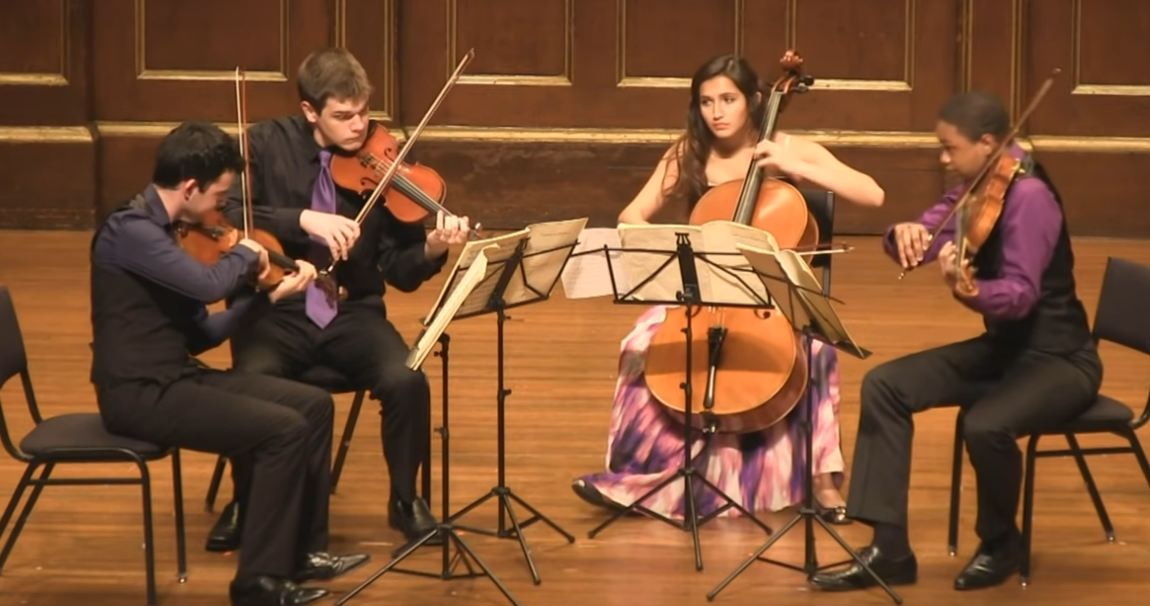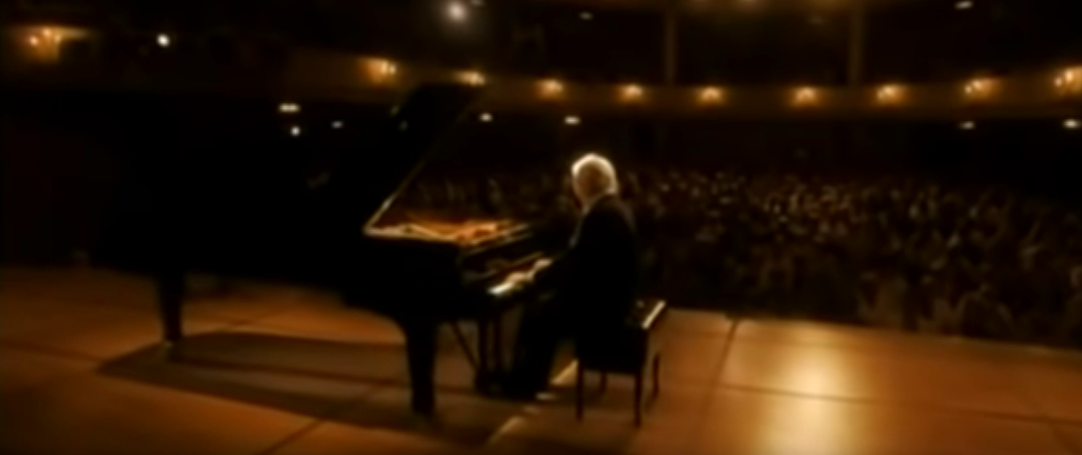5.3: Chamber Music in the Classical Era (1750-~1820)
- Page ID
- 165600
Chamber Music in the Classical Era.
The Classical Era that followed the Baroque Period was covered in-depth in the previous chapter. There, you learned about one of the most important chamber ensembles that came out of this time period: the String Quartet.
String Quartet.

Matthew Vera and Michael Rau, violins David Mason, viola Marza Wilks, cello. Screenshot taken from YouTube.
As a reminder, the string quartet contains four different string players and arranges them in the four ranges of music:
Violin 1: Soprano
Violin 2: Alto
Viola: Tenor
Cello: Bass
String quartets were among the most popular and "sophisticated" types of instrumental chamber music of the Classical Era. Revisit Chapter 4 that covered the 4-movement cycle, in particular, the string quartet and symphony. Recall that the 1st and 4th movements were typically fast and in sonata and rondo form, respectively. The 2nd movement is typically a slow movement written in any form, and the 3rd movement is often an upbeat dance movement.
While the string quartet was the one of the most important genres to come out of the Classical Era, it was not the only one. Classical Era composers continued to write Instrumental Sonatas similar to the Baroque composers, but these sonatas were organized in a very strict manner. (Remember that Classical composers were very interested in how they approached form, so Instrumental Sonatas were often organized the same way.) Composers also wrote Piano Trios, which combined a pianist with a violinist and cellist. Some composers would even combine the piano with well-established genres like the string quartet, or would even combine a pianist with a group of wind players. Because of the piano's importance in chamber music of this time period, let us first address the piano in more detail.
The Piano.

Daniel Barenboim performs a solo piano sonata on stage. Screenshot taken YouTube.
The piano was invented in the early 1700s, and became one of the most popular instruments in the Classical Period. Although Chapter 7 covers keyboard instruments including the piano in more detail, it is difficult to discuss chamber music in the Classical Era because almost all of it included the piano to some extent. As the harpsichord fell out of popularity toward the end of the Baroque Period, the piano essentially took over as the go-to keyboard instrument, especially when accompanying other instruments. All of the great prominent composers of this era wrote music that included piano. Because of its ability to play both high and low notes and its ability play chords and melodies simultaneously, the piano made a great partner for instrumental chamber music of the Classical Era. The piano was featured as the accompanist in many Instrumental Sonatas, similar to how the harpsichord was featured in instrumental sonatas of the Baroque Period that came before. Take a look at this video here that shows how a piano works before moving on.
The Instrumental Sonata.

Julian Rachlin (violin) and Johannes Piirto (piano) perform a violin sonata live on stage. Screenshot taken from YouTube.
The instrumental sonata was a popular genre in the Baroque period, and this tradition carried through the Classical Era, and even until today. However, modern sonatas are based off of the type of instrumental sonatas that came out of the Classical Era: they often contained three movements, the first of which was typically in "sonata form," and the last often begin in "rondo" form—both of which were often fast. The second movement, which was typically slow, would often be written in any type of form that the composer chose. This is similar to the 4-movement instrumental cycle that you read about last chapter: the outer movements are fast, and in sonata or rondo form, and the slow movement can be written in any form desired. The only thing missing from the instrumental sonata was the "dance" movement.
Composers wrote many sonatas for many different instruments, all of which included a piano as its accompanist, violin sonatas, flute sonatas, clarinet sonatas, cello sonatas, etc. Among these combinations, however, composers favored the Violin Sonata and Cello Sonata more than others. Take a listen to this recording of Beethoven's "Spring" Violin Sonata; you'll notice how well the piano blends with the violin during this performance. When we get to Chapter 7.2, we'll examine a piano sonata and its form.
The Piano Trio.

Henry Kramer (piano), Arianna Warsaw-Fan Rauch (Violin), and Meta Weiss (cello) perform Ravel's Piano Trio. Screenshot taken from YouTube.
One of the most popular genres to emerge out of the Classical Era was the piano trio. Continuing with our "annoying use of terminology" found in music, the piano trio can refer to both the ensemble of performers, as well as the musical work itself. "I'm a member of a piano trio, and our recital will feature Beethoven's ninth piano trio, among other works."
Piano Trios were often written in the same form as the Symphony and String Quartet: they often contain four movements. The first and fourth movements are typically fast, and in sonata and rondo form, respectively. Movements 2 is often slow and written in any form the composer chooses, and the third movement is often a lively dance.
The piece in the Video Presentation addresses one of Beethoven's well-known piano trios, referred to as the "Archduke Trio" because Beethoven had dedicated the music to Archduke Rudolph of Austria, who was an amateur musician, and a friend and composition student of Beethoven. You might notice that the second movement is a dance, instead of being slow! As the Classical Era progressed, it became quite common for composers to switch the 2nd and 3rd movements within larger 4-movement works.
Now that you've read through these different types of instruments and genres found in Classical Era chamber music, watch the Video Presentation, which discusses this in more detail, and covers Beethovens' famous work.

